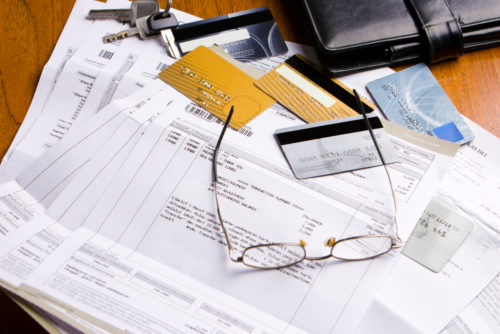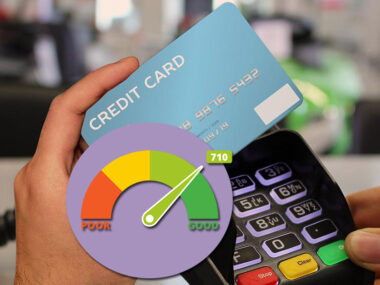
When you’re first learning about credit and how your score is determined, you may come across some new and unfamiliar terms. One of those terms is “utilization ratio,” and this concept makes up a large chunk of how your overall credit score is determined and how healthy your credit history is.
Besides all your loans such as a mortgage, car, or student loan, you may also have lines of credit; or credit cards or credit accounts (depending on your bank). Your utilization ratio has to do with how much of your lines of credit are used and how much available credit you have remaining before you reach your limit.
How do credit cards affect your credit utilization ratio, and what can you do to have a positive influence on your overall FICO credit score? The key to a good credit score is having a stable but low credit utilization ratio.
Table of Contents
What Is a Credit Card Utilization Rate?
Your overall credit utilization ratio will be used to help determine how healthy your current credit card accounts are — essentially how much debt you’ve used up already on your cards, and how large a balance you carry over each month. This number is highly influential to your overall credit limit, so it’s important to understand how it is calculated and how you can improve it in case you have a low or fair credit score.
To determine your credit utilization ratio, you calculate all the debt that you owe (your current card balance) and you compare that to the maximum amount of debt allowed (your credit limit) on every account.
If you have multiple cards, then you add together all the maximum limits for each card, and add together your total credit card balance. Then divide the balance by the overall limit, and multiply that number by 100. This will give you your credit card utilization ratio as a percentage.
As a formula this looks like:
(Total balance) ÷ (total credit limit) × 100 = percentage of credit utilization
For example, if you have a credit card with a $10,000 limit, but your balance is about $3,000 on that credit card, then you’ve only used about 30% of your credit limit — which is your utilization ratio for that card.
($3,000) ÷ ($10,000) = .30 × 100 = 30% of credit utilization
Credit Card Utilization and Your FICO Credit Score
There are multiple factors that go into determining your overall FICO score — some more important than others. Below are all the factors that affect your score:
- 35% is dependent on your payment history
- 30% is dependent on your utilization ratio
- 15% is dependent on the average ages of your credit accounts
- 10% is dependent on new credit added within the past 6 months to 1 year
- 10% is dependent on the types of credit utilized (loans, credit cards, mortgages, etc.)
As you can see, credit utilization is one of the strongest factors that will influence your overall score, which is why it’s so important to understand its significance. Utilization will look at all the loans and debt that you have under your name and social security number. Credit cards, however, tend to have the most power simply because they are the most common credit-building mechanism that people have in their wallet. They also are the most flexible.
When you first get a mortgage, for example, your credit utilization will be fairly high, as you’ll still owe a significant amount on that loan. However, all your payments are predetermined through your PITI, and — although you can always pay more — chances are it will still take some time before your utilization ratio on a mortgage loan drops to a lower percentage.
Credit cards, on the other hand, always start out at zero. You can build up how much you owe as you spend using your card, and you have more control over paying off your debt and limiting your spending. So if you have a credit card account, it’s important to remember to keep your utilization ratio low in order to improve your overall credit score.
What Is a Good Credit Card Utilization Ratio?
The top major credit bureaus — Experian, Equifax, and TransUnion — recommend that your utilization ratio stay at or below 30% of your overall credit limit. The lower your utilization number, the less relient you are on credit, which shows creditors, lenders, and the bureaus that you are responsible with your credit spending.
Having a utilization ratio slightly above 30% isn’t bad either, as long as you can show that you’re paying down your debts on time and are also being a responsible lender by not opening up too many new accounts at once, or engaging in other potentially dangerous lending activities.
How To Improve Your Credit Card Utilization Rate
If you do find your utilization ratio is far above 30%, one easy way to improve it is to ask for a credit limit increase from your credit card provider. Keep in mind, if you’ve recently asked for a new line of credit or loan, it may be detrimental to ask for a credit increase as it will show that you’ve had multiple recent hard inquiries on your credit score. However, if you haven’t opened up a new line of credit or had a hard inquiry in the past year, you may be able to improve your utilization ratio if your credit provider increases your overall limit.
On the reverse, if you decide to close a credit account, be aware of what effect this may have on your overall credit utilization ratio. If you have $4,000 in debt with a limit of $12,000, and you drop down to an $8,000 limit, your credit utilization will go from 30% to 50% — which will have a negative effect on your overall score.
Here are a couple other options that may help you improve your credit card utilization ratio:
- Your credit utilization will fluctuate as your lender/credit provider updates your account with the credit bureaus. Because of this, if you pay down a certain amount of your bill before they report to the bureaus, your utilization ratio may appear lower than if it was reported during the peak; before you paid down your account. So, if you are able to find out when your creditor is reporting your information, you may be able to make your utilization ratio appear smaller to the bureaus by paying prior to the reporting date.
- You can also spread your spending across multiple accounts, lowering the credit utilization of all your accounts just slightly. Keep in mind, this will not influence your overall credit utilization — unless you open a new account or get a credit limit increase.
- Another option is to pay off your balance in full — or as much as you can afford — in order to keep it low every month. It can be difficult to pay down large amounts all at once, but if you have a reasonable balance on your account, this can help keep your utilization low every month.
Image Source: https://depositphotos.com/





